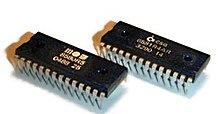Chiptune
Chiptunes are a genre within computer-generated music that is characterized by a characteristic artificial sound. The origin lies in the home computer and video game era.
The original chiptunes were generated by sound chips with relatively primitive tone generators. Here, 3 to 4 tones could be generated in parallel in real time . Compared to the most primitive electronic tone generator, which only generates a sinusoidal beep, these sound chips could already influence the waveform differently and also generate noise. The result sounds so clearly recognizable artificial, even if one kind of different unnatural musical instruments can be interpreted.
Bitpop is a related genre .
history
The term Chiptune comes from the era of the Amiga home computer , which with its Mod file format already offered musicians the opportunity to work with samples and thus gave them greater freedom with regard to the sound. Despite considerable technical limitations, this went in the direction of modern synthesizers, which can imitate natural musical instruments deceptively real. If a musician continued to use the tone generators of the sound chips of the time conventionally, or at least the result sounded like that, his work was referred to as "Chiptune" in order to differentiate it from more modern sampling music.
Chiptunes usually have a small amount of data , very similar to the MID file format based on MIDI , and were therefore often used in intros from the demo scene - as well as cracktros from release groups from the warez scene, where it is necessary to use as little storage space as possible .
Real chip tunes are still in a niche outside of techno , electro-pop , industrial and the like. a., but often remind of these genres. The scene also sets itself apart from ring tones and does not want to be associated with it. The claim to create the music with modern trackers from speech samples and effects goes far beyond that. Some “chip tuners” see techno or the techno wave of the 1990s as just an offshoot of their work, an inflation of their earlier work and the degeneration of the original chip tunes for the masses, although some have also found themselves there successfully.
composition
Chiptunes are characterized by the rare occurrence of actually polyphonic chords in the classical sense. With chiptunes, chords are usually formed using arpeggios in order to save soundtracks . This restriction is based on the fact that the first sound chips could rarely play more than three sound channels in parallel - playing a chord would often have occupied all available channels.
Because of this “shortage of voices”, many chiptunes have a very complex structure. To allow more than just three instruments to sound, the gaps in a melody, for example that of the bass, are used to sound another instrument or an accompanying voice. Thus there are two or more melodies or voices on one channel. This technique is useful for using rhythms with many preferred elements. A very funky style has developed in the area of SID tunes .
Another technique for adding more voices is often found on the canal where the bass and the percussion instruments can be heard. A noise is placed in front of the individual bass notes for a fraction of a second. This creates the impression of a kind of hi-hat of a drum kit. However, due to the removal of the channel limitation of modern trackers, there are largely no technical restrictions for composers today.
literature
- Nils Dittbrenner: Sound chip music. Osnabrück: epOs-Music 2007, ISBN 978-3-923486-94-6
- Julia Mihály : low tech music for high tech people . In: MusikTexte 155, 2017, ISSN 0178-8884
Web links
- Interview by Radio Unerhört Marburg with the Micromusic headquarters in Berlin about micromusic.net and chip music in general
- Chiptune Online Player: Amiga , C64 , AtariST , Mod
